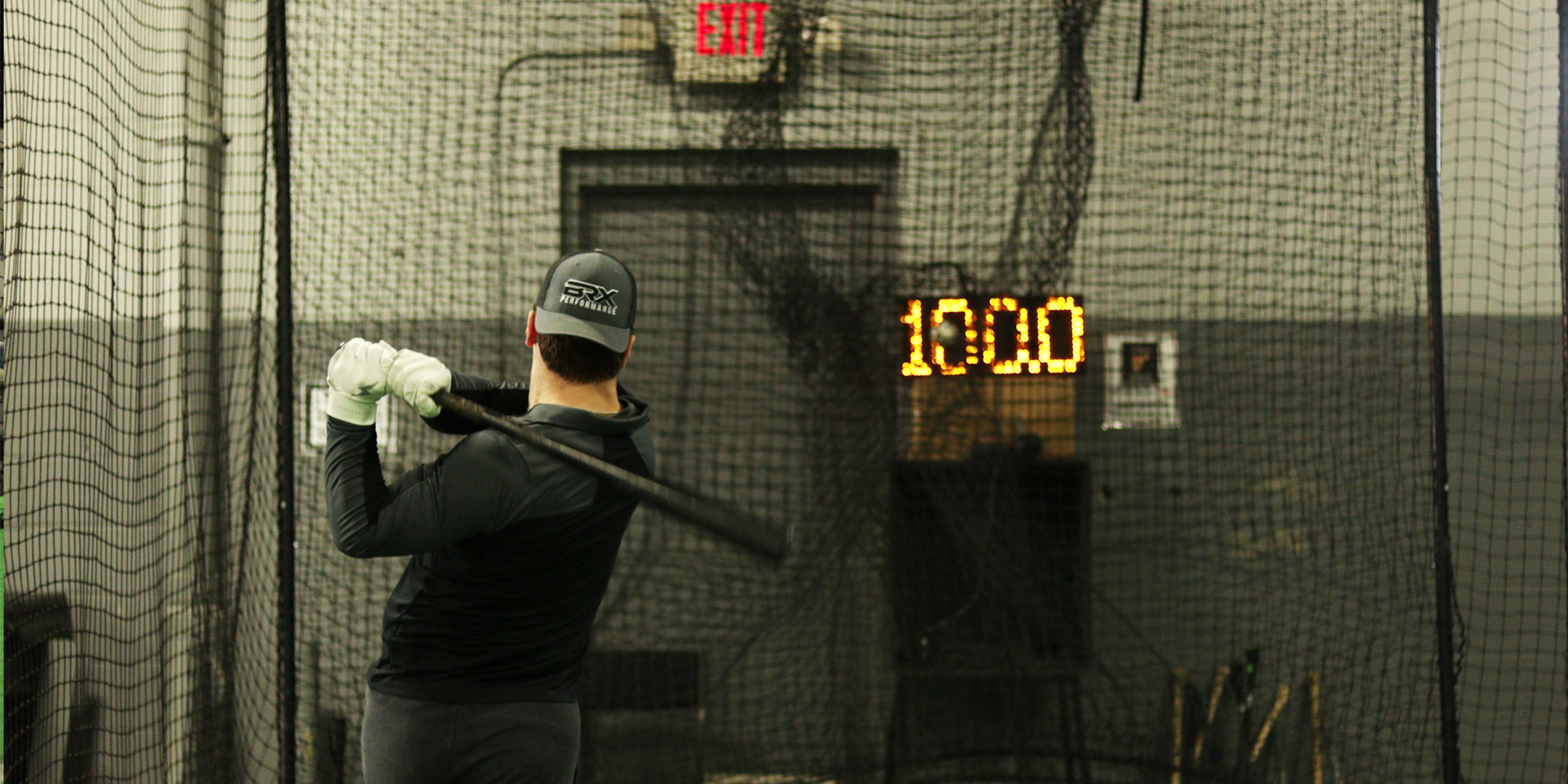A $112,000 Scholarship, 100 mph Fastballs, and a 6.54 60-yard Dash
June 06, 2017
Do you or your son want to play college and professional baseball? Are you frustrated by your...
In the day and age of showcases, numbers matter. While no one would argue that a 95 MPH fastball equates to a great pitcher or 100 MPH exit velocity a great hitter, improving the horsepower of your engine can only help. Often, a couple of MPH difference in velocity is the difference between who gets offered the scholarship and who does not. With that said, I am going to discuss the exit velocity test and five tips for improving it.
The exit velocity test is simple: a radar gun records the speed of how hard an athlete can hit a baseball off of a tee into a net. Scouts and coaches use exit velocity as a measure how much force a player can transfer from the body through the bat and into the ball. Having a high exit velocity does not directly translate to being a good hitter, there are valid reasons why exit velocity is important to coaches.
Biomechanical researchers found that a ball leaving the bat at 90 MPH traveled about 300 feet, 95 MPH 326 feet, 100 MPH 350 Feet and 105 MPH 375 feet.
The research concluded that for every 1 MPH added to exit velocity, the ball traveled an additional 5 feet.
Coaches see exit velocity as a measure of raw power and use it to project power numbers at the plate. The exit velocity test in baseball has the comparison to the bench press, vertical, or broad jump test in football. Having a good vertical jump does not make someone a good football player, but it is a great measure of how much power the athlete’s body can produce. Mechanical improvements can improve exit velocity, but can only take you so far. Once the body has reached its power potential, the only way to continue development is to increase the amount of force the body can produce. Compare a hitter’s body to the horsepower output in a car’s engine. Tuning a car can improve efficiency and maximize speed, but the car at some point will reach a peak velocity. Once you reach that point and you still want a faster car then we have to build a bigger engine.
A prime example of a guy with a motor of a Ferrari showing his rotational power hitting 101. (He’s a pitcher in the Padres organization…)
There is no magic technique that can guarantee a 100 MPH exit velocity, as seen by Lake’s video. Lake does not have the most efficient swing but generates 100+ exit velo because he has built a powerful motor.
Everybody’s body works differently so everybody will have a swing that works most efficiently for their body. However, there are a few common keys and mistakes that add or take away from exit velocity.
Swinging down is the biggest detriment to exit velocity readings. Radar guns give the most accurate reading if the ball is hit/thrown in the direct line of the gun. A ball hit in another plane is wasted velocity.
As I mentioned previously, the exit velocity test is a measure of how much force the player can transfer from their body through the bat and into the ball. If the bat is traveling at any angle besides directly towards the radar gun at contact with the ball, power is being wasted and exit velocity is not at its peak potential. Two players might have the same swing speed, but one will show a higher exit velocity if the bat is traveling on a level plane at contact.
The bat transfers the force from the body into the ball so it undoubtedly plays a large role in ball velocity, but how much do bat length and composition really affect exit velocity? Wood bats are great training tools in the offseason due to a smaller sweet spot and instant feedback given by bat vibration and sound. However, come showcase day for high school or college players, metal bats will outperform woods bats in exit velocity tests due to the increased trampoline effect and larger sweet spot.
As for bat size, experiment with different sizes and see what works best for you. You want to find the perfect mix of bat weight and swing speed. This will be different for everybody based on varying strength levels and swing mechanics, but this is where the Force = Mass X Acceleration equation comes into play. You don’t want to swing a bat too heavy because it will reduce acceleration and decrease exit velocity (force). At the same time, don’t swing a bat way too light, because while swing speeds may be very fast, the essential mass will not be there to output enough force for a high exit velocity reading.
In an exit velocity test, there is no standard for where the tee must be placed or what height the tee must be set to. Ball exit velocity will be greatest when the player hits the ball straight up the middle (where the radar gun sits), but the tee can be moved around in the player’s stance to match their optimal contact point. Every hitter’s swing is different so every hitter has a different optimal contact point.
Some players prefer to get more extension at contact so they set the tee for a middle-outside pitch. Others get on plane easier with a low pitch so they lower the tee to maximize their swing path. These differences occur because all hitters have a point in their swing at which they achieve maximum bat acceleration. If maximum acceleration is achieved at ball contact, ball exit velocity will be maximized for that hitter. However, if they are still accelerating or even decelerating at contact, ball exit velocity will decrease
There are three positions in the launch phase of the swing that the hitter must achieve so the body can produce maximal force. The first position is the bat angle. To properly load the hands, the hitter can imagine a catcher behind them and angle the knob of the bat towards the imaginary catcher’s mask. This gets the wrists into an optimal position for force production without over-wrapping the bat behind the hitter’s head. Bat acceleration is a huge factor in ball exit velocity and the hitter’s hands/wrists are responsible for transferring the force rapidly from their body through the bat and eventually to the ball. The hitter’s hands must be in a strong position to do so.
The second position is weight transfer to the backside. To be explosive forward, the hitter must first load their weight into a strong back leg. It does not matter if they have a leg kick, toe tap or any other load style as long as they get their weight to their back leg.. This is crucial so that the hitter can utilize the strongest part of their body – the lower body – to provide the power for the swing.

The last position is the loading of the core. The core is responsible for transferring force from the lower body to the upper body. If the core is weak or not in a strong position, some or all of the force from the lower body will not be transferred through the kinetic chain and into the bat. Loading the shoulders slightly down and rotated in will provide the “rubber band effect” once the hips rotate forwards to initiate the swing. A hitter can have the strongest lower body in the world, but lack of core strength equals little force transfer from lower body to bat.
The popularity of internet-hitting videos that are readily available has been a blessing and a curse for hitters. Online tutorials have allowed anybody with internet access to gather more information on how the swing should look and feel. However, this has also led to over-analyzing swings which result in robotic and unnatural movements. Rather than focusing on timing and identifying the pitch, hitters are concerned with mechanics. At showcases, coaches will label this hitter as the “lesson baby” due to the choppy and robotic movements in the swing.
Having flow and rhythm to the swing will allow the hitter to stay loose and whip the bat through the zone. Coaches place value in athletic swings because they know that the bat speed will transfer to game-like situations and robotic swings will not. Loose muscles are efficient muscles so having a rhythm and flow to the swing will produce a higher exit velocity than a tight and robotic swing. Mechanical work is important to build confidence and efficiency, but when it comes time to compete, all mechanical thoughts must go out the door.
Are you struggling to increase your throwing velocity, exit velocity, or running speed? Don't worry; you're not alone. That's why we have developed BDS, Baseball Development Secrets. The Baseball Development Secrets System (BDS) is a baseball-specific strength training program specifically designed to increase throwing velocity, exit velocity, and running speed. The best part is you can get access to our program for 7 days free of charge! If you're serious about your baseball development, Baseball Developments Secrets could be that answer for you as it has been for hundreds of other baseball players. Start your FREE trial today!
June 06, 2017
Do you or your son want to play college and professional baseball? Are you frustrated by your...April 26, 2023
ATHLETES: How are you evaluating the progress and improvements you are making towards your goals?...